Serbariu coal mine
39º 9' 38'' N 8º 29' 35'' E
South
Italy
Description
The Serbariu coal mine museum Italian: Centro Italiano Della Cultura Del Carbone is a mining museum in Carbonia, Sardinia. The museum is an Anchor point on the European Route of Industrial Heritage.
Extracted Materials
During the exploitation of the coal deposits, (so called Lignitifero), mines of the Sulcis Area, in over a century of mining, have produced large underground excavations, which were extracted more than 50 million tons of coal and large quantities of tailings.
Antropological info
The Great Mine of Serbariu was the largest mine in Italy, with 18,000 employees of whom 16,000 were miners. It occupied 33 hectares on the surface and 100 km of underground chambers. It opened in 1937 and was worked until 1964.
Sociologal info
This work aims to contribute to knowledge on the phenomena of sinkholes in the urban area of Carbonia, primed mostly as a result of mining in underground coal Sulcis, as well as natural causes, in the hills and valleys structurated on the bedrock of Cambrian area, in the localities of Cannas and Serbariu
Archaeological info
There have been found important effects of instability of the soil in urban areas and in the recently built road infrastructure linking lots of settlements. The area affected by mining operations has an area of over 4 square kilometers, is covered in part by the built environment and road infrastructure of regional and state level. In the mining center, now converted to craft and commercial area, have continued various undergrounds mining collapses, with the opening of pits on the surface, circular or elliptical, formed by highly inclined or vertical walls.
Sustainable tourism insights
The museum, which opened 3 November 2006, shows the pit head works and an underground gallery with the tools used from the 1930s to the 1950s, and also concentrates on the social history of mining.
Environment sustainability
The first signs of instability are occurred with the sudden opening of large potholes and structural damage to buildings up area of Bacu Abis, in neighboring areas to the Mine of Serbariu, intended for production facilities ("Su Landiri Durci"), and along certain streets service. In the case of mine "Serbariu" located on the outskirts of the urban west Carbonia, exploited in the period between 1940 and 1964, the cultivation of the layers of coal left in place, at short depth from the surface level, consisting of empty mines, with more than 5 km of galleries. So, have been found important effects of instability of the soil in urban areas and in the recently built road infrastructure linking lots of settlements.









